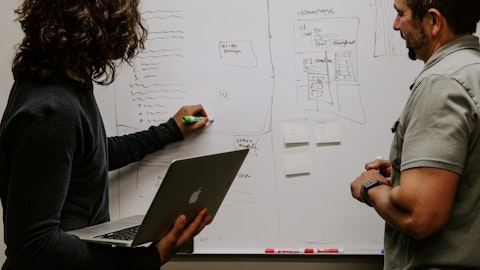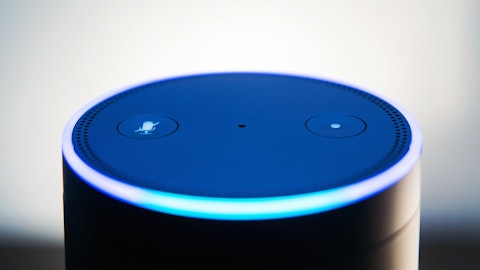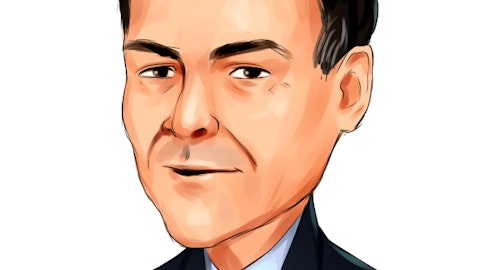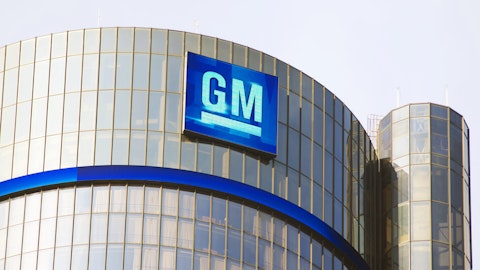Jay Geldmacher: And I’ll add one other thing is that on the security thing that Tony brought up, we’re going to be introducing the pro EMEA the pro-series that we introduced in the North America has been a strong new product for us and that the pro EMEA one comes out in a few months and that addresses some of the issues that we had in Europe. We have several other new products going into the security portfolio over the next six months that we’re excited about. The acquisition of Technique that we’ve talked about that gives us some additional capabilities beyond our innovation technology and existing engineering organizations is going to provide some really cool things from the standpoint of video analytics, AI and other capabilities that helps accelerate to opportunities there.
Erik Woodring: Awesome. That was super helpful, I really appreciate that kind of color. I guess maybe the second question is just on gross margins, obviously I know this has been a big point of emphasis for you guys and again certain specific headwinds in terms of volumes in 2023. Can you maybe rank order for us what has the most significant or what’s the most significant headwind versus what the potential tailwind as we think about 2023? And I imagine most of this is on the P&S side but just correct me if I’m wrong there? Thanks.
Tony Trunzo: Yes. Eric, I’ll address both. I’m doing this a little bit off the top of my head, but I think this is correct. Probably the single biggest factor in 2023 is factory deleveraging. Even though we’re seeing expanded price, we’re going to see unit volumes come down. We’ve responded to that in this restructuring by addressing some direct labor and some other inefficiencies, but we have not yet been able to really achieve a lot of the factory optimization that we’ve been pursuing over the — that we’ve been talking about over the last couple of years. We did just say that we’re doing our first one now and I think we’ll be doing more. But we do have somewhat of a rigid cost structure. So the factory deleveraging I think is the biggest one.
The second is we’re still seeing some inflation in 2023. We’re factoring in some element of increasing inflation — some element of higher material costs. And while we’re responding to that with some targeted price action, we’re not going to get sort of incremental margin on top of the price that we’re putting through at this level and at this stage of the cycle versus the inflation that we’re seeing.
Jay Geldmacher: I’d also add, Eric, that we’ll be a little careful, because of the fact that even though ’21 and €˜22 as everybody in the world knows was really challenging on the supply chain and material costs, the inflation that increased last year. In certain aspects of that, in certain pockets are getting better in 2023, but there’s others that aren’t yet as I think most everyone knows. And so we’re being careful in terms of the speed of that. I personally think and question that you have as well as some of the other folks that I think that this will continue to improve throughout the year, but timing is going to be when we have to watch closely as part of that. So that’s all tied to that along with what Tony said.
Tony Trunzo: Yes. And then also maybe to add with respect to ADI, they benefited last year from some inflationary trends in their business. That was about half of their margin expansion for the year. The other half was really through a lot of the initiatives that we’ve been investing in with respect to that business. Our outlook for this year, kind of, incorporates plus or minus flat margins for ADI. And we see that probably as maybe better than some of the other news in the distribution space, largely because of the levers that we can pull still around price optimization. And as importantly around our exclusive brands, those products have dramatically higher margins than our average and they continue to grow at a much, much faster rates than the overall business?
Jay Geldmacher : By the way, on P&S, one thing I neglected to mention is we continue to see direct labor inflation as well. We have pretty significant factory footprint in Mexico and Mexican wage rates have definitely trended up and that’s continuing in 2023.
Erik Woodring: Okay, super. Thank you for the color. And just to mention the ADI performance is very strong for you guys and Rob, I took my cap to you guys.
Jay Geldmacher: You do a great job.
Tony Trunzo: Thanks.
Operator: Thank you. We go next now to Ian Zaffino of Oppenheimer.
Ian Zaffino: Hi, great. Thank you. I just wanted to kind of build on that last question or last answer. What are you assuming for pricing into 2023? And how do you also think about pushing price in the face of declining volumes? I know you’re trying to get a material and inflation recovery, but maybe also talk about the competitive environment, maybe your ability to do it in that environment? Thanks.
Jay Geldmacher: Yes. Clearly, I think we — our expectation is for less in the way of price increases this year than we saw last year and in the latter part of 2021. They’ll be targeted. They’ll be focused in areas where we’re seeing underlying increases in our cost structure. And we’re always going to be attuned to the competitive environment and making sure that we put ourselves in a position to remain competitive. I think there’s still a lot of inflation in the world, right? I mean, today’s inflation numbers were not awesome. And I think there’s a general recognition that while maybe getting a little bit better. Inflation hasn’t really gone away. But I think you’re right. We want to make sure that we’re focused on the competitive environment and when we look at that dynamic, the data points that we see indicate that we are incrementally gaining market share. So we feel good about our execution in the market in the environment as well.
Ian Zaffino: Okay. Thank you. And then I wanted to talk or ask you guys about some of the new products a lot of them are in the monitoring category and what should we expect as far as maybe revenues or how is a lot of these new products that you’re trying to introduce on the monitoring side? How is that, kind of, tracking your expectations of what you could get maybe recurring revenues to and which we expect this large growth? Thanks.
Tony Trunzo: Yes. I’ll make a couple of comments. I suspect Jay probably has some input as well. So Jay kind of gave a little bit of a laundry list. The majority of the products that we talked about just now are connected or connectable, which means that as we build out our overall ecosystem which has frankly been a significant effort internally over the last year and a half with respect to investment, the chunk of our investment in R&D going in that direction. So the thermostat and water leak detection, they’re all sort of early pieces of what we are working to develop in terms of it like fully connected ecosystem. There’s always going to be new products that are going to come in that are outside of that ecosystem. But the primary thrust is really the — is really on the connected products.
Given that we are building that out sort of piece by piece, there’s going to be a — we think a network effect as we get to a certain critical mass of products where you’ll see a more meaningful contribution of revenue. I would point you to the products that we just talked about today as being a key driver to their revenue performance this year, but I think as we look further out and we look to have more and more of our products on that platform, I think a lot of the focus is really going to be on driving revenue across that platform and with more products on it, we think that in and of itself will help to accelerate the revenue.
Jay Geldmacher: Yes, I would say, also Ian, this expansion of the ecosystem that Tony mentioned, and as you know, we’ve been talking about that material quite a bit over the last year, and even as we’ve built that out both from a software platform standpoint, we need a hardware to be — it all drive that and to expand that and in terms of the total offering. And then what does that provide, gives us opportunity as you’ve just asked a few minutes ago for — opportunity as well as things that we’re doing that we’ll talk probably more about it in the months ahead in areas of services. So I think that’s why I told you, as I mentioned on the previous question of the other caller, how excited I am that now I really see a velocity change increasing of the cadence of new products coming out and that’s how it is so important in terms of the total ecosystem play that I think helps differentiate us in the marketplace.
Ian Zaffino: All right, great. Thank you very much.
Operator: Thank you. We got next out to Paul Chung at JPMorgan.
Paul Chung: Hi, thanks for taking my questions. So just on the manufacturing initiatives, so are you looking to outsource more of the P&S portfolio? Or if you could expand on some of the cost initiatives you’re thinking about and the respective impact on longer-term margins and cost saves et cetera?
Tony Trunzo: Sure, it’s going from in-source to outsource is part of it, but there are sort of range of activities going from trying to be more efficient in the factories we have to the efforts that we have going on at first or initially around factory automation, which we think is going to is going to create some really great leverage in the cost environment in those factories to certain areas where we will look to outsource. I want to make clear that we’ve been cautious and are going to continue to be cautious about how and where we outsource being mindful of supply chain resiliency. We have some rigidity in our cost structure, but we also have a pretty good supply chain resiliency today, because of that because we’ve got a lot of end market factories.
And we’re going to continue to work to balance the transition to a lower cost footprint, while keeping in mind that resiliency. But there’s any number of steps, the one that we reserved for in Q4 is the first and I think clearest opportunity, but there’ll be more as we roll through 2023 and €˜24.
Jay Geldmacher: I think I may have mentioned Paul, maybe just very — at a high level in the last call that there is a number of the factory optimization projects that we actually had built the plans for, but during COVID and during supply chain craziness, we were very cautious not to impact ourselves by moving forward on some of those, because of the risk it provided or the risk that it would have created. And now with us coming out of that of course now it gives us the opportunity to really exercise our playbook in terms of a variety of different things, factory cost optimization, the automation piece that Tony just talked about for First Alert, but automation opportunities and other parts of the company and I’m excited about that too, because it gives us levers that we had to put on the sideline for a while until we’re in the position we are now and that the folks that we brought in over the last few years that are very good at that and have a lot of experience in doing that work.
Paul Chung: Great, thanks for that. And then just to follow-up on First Alert, you mentioned the asset performing better-than-expected this year. So what in your mind drove that incremental upside to your original projections? And then how do we think about the momentum of this asset heading into €˜23 and then other assets you may be looking at to complement the portfolio? Thank you.
Jay Geldmacher: I’ll comment, Tony will too, because I see him over your way to be down. But the integration, I think what — better-than-expected. You never know when you do any acquisition, I don’t care if it’s $10 million, $400 million to $4 billion. Some of the things that are somewhat unpredictable, but I am very pleased to say that the teams both from the First Alert team people of Resideo worked super well together and that’s part of the reason why we’ve been able to outperform some of the things that we had laid out in our original business case. And then from a standpoint of your question about opportunities moving forward in the future. I mean, as you know the types of products in the First Alert portfolio. There are types smoke, carbon monoxide et cetera, they’re in the house or in small business offices and there are in many, many different places and so it’s additional sensors that are in the building, it comes back to the ecosystem comment that we were talking about before and that gives us opportunity to connect all this in certain products and incorporate new types of things with off the base platforms of those as we move forward.
So we’re excited about the opportunities there, our innovation and technology group has come up with some pretty cool ideas that we can productize over the years ahead that help us. And then of course, leveraging our channels that we have that are really super important and that’s one of the big things that were tied to the — on the commercial side of things of leveraging the strength of Resideo’s very strong commercial channels, our pro network. And so you can hopefully can tell by my voice, I’m pretty excited about what we’ve done in less than a year and where the future holds.
Tony Trunzo: Yes, the only thing I’d add to all that is there is a transition in the standards requirements for smoke and carbon monoxide detectors that are coming out in the middle of 2024 that we’re pretty excited about our position in terms of being able to capitalize on that, we’re pretty excited about the product offerings will have in that category that should drive some continued growth as we basically enhance the technology. And to the point Jay made about the additional sensors and real estate and the connected ecosystem, there’s a fair bit of work underway now to capitalize on the First Alert products to bring them into that ecosystem. So looking forward, I think that this is an area of real meaningful growth for us.
Paul Chung: Okay, great. Thank you.





